While many backyard birds approach feeders with straightforward precision, certain species transform this everyday activity into breathtaking aerial displays and gravity-defying maneuvers. These avian acrobats have evolved specialized physical adaptations and behaviors that allow them to access food in ways that dazzle human observers. From hanging upside-down to hovering in mid-air, these feathered performers demonstrate remarkable agility and balance, turning your backyard into an aerial circus. Their impressive acrobatic abilities aren’t just for show—they represent evolutionary adaptations that help these birds access food sources that would otherwise remain beyond their reach, giving them competitive advantages in their ecological niches.
Chickadees: The Upside-Down Specialists
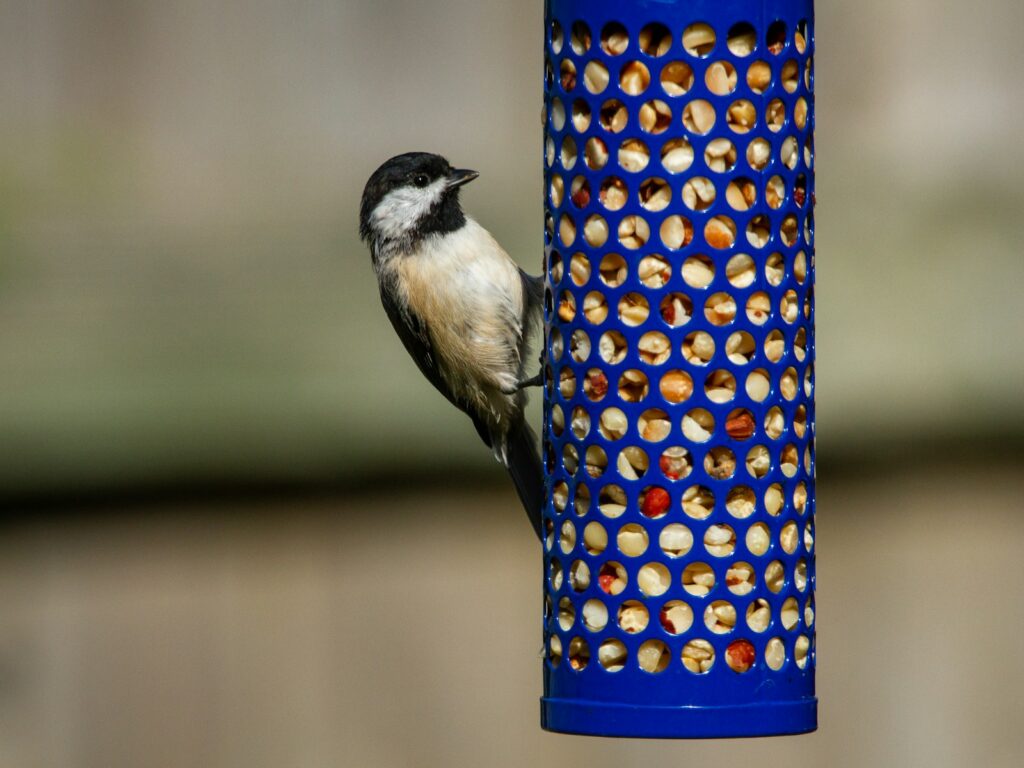
Black-capped and Carolina chickadees are among the most nimble visitors to backyard feeders, regularly defying gravity with their acrobatic feeding style. These tiny birds can rotate their feet 180 degrees, allowing them to hang completely upside-down from perches, branches, and feeder ports while extracting seeds. Their remarkable balance enables them to maintain this inverted position for extended periods, casually feeding while suspended as if gravity were merely a suggestion rather than a law. This adaptation evolved to help chickadees forage on the undersides of branches and leaves where many insects and their eggs hide, giving them access to food sources that more gravity-bound birds cannot reach.
Nuthatches: The Downward-Climbing Experts
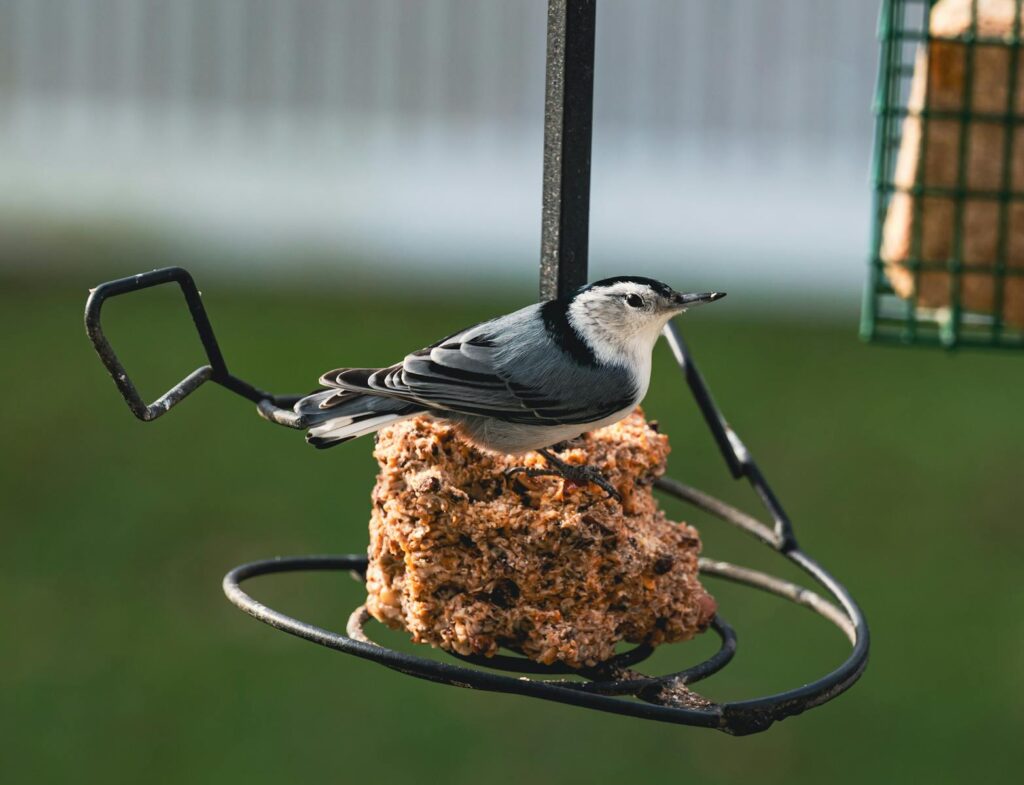
White-breasted and red-breasted nuthatches have perfected the art of walking headfirst down tree trunks, a rare skill in the bird world. Their strong legs and specialized feet feature an enlarged hind toe and curved claws that create an exceptional grip, allowing them to navigate vertical surfaces with remarkable security. This downward orientation gives nuthatches a unique perspective on finding food, letting them spot insects and larvae that other birds miss by approaching from the opposite direction. At feeders, they demonstrate this same headfirst approach, often descending vertically onto hanging feeders and extracting seeds while maintaining their distinctive upside-down posture, sometimes even eating while completely inverted.
Hummingbirds: Masters of Aerial Suspension
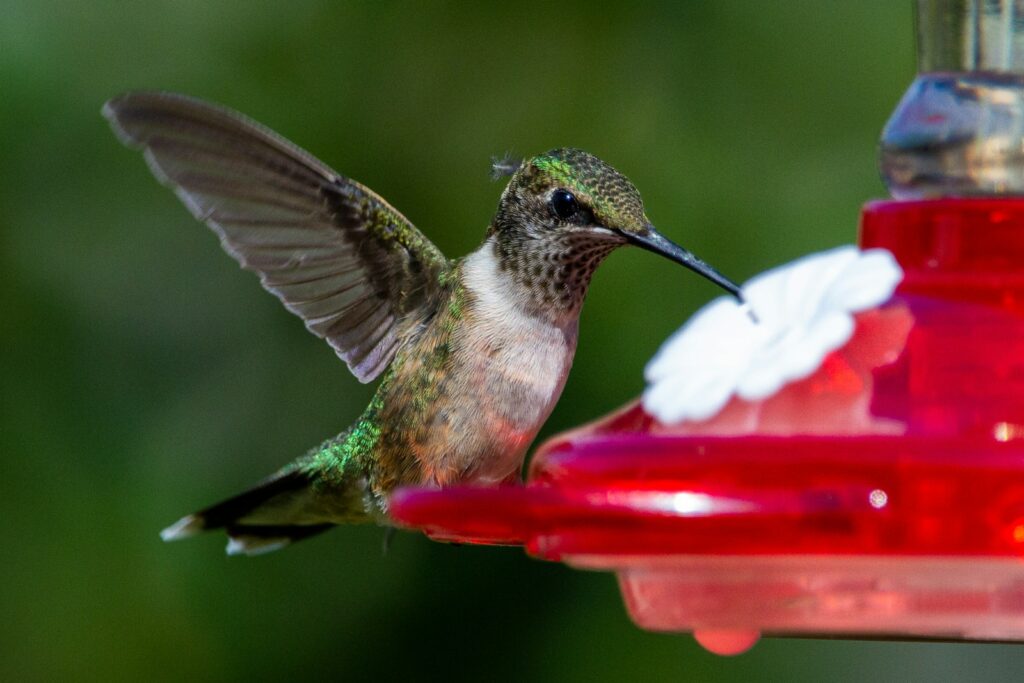
Hummingbirds represent the pinnacle of feeding acrobatics with their unmatched ability to hover perfectly in place, accessing nectar without perching. These avian helicopters can beat their wings up to 80 times per second, creating the characteristic humming sound while maintaining remarkably precise position control in three-dimensional space. Their specialized shoulder joints allow their wings to rotate in a figure-eight pattern, generating lift on both forward and backward strokes—a unique adaptation in the bird world. This hovering ability lets hummingbirds access flowers and nectar feeders that would be inaccessible to perching birds, while their long, specialized bills and extendable, tube-like tongues can reach deep into flowers to extract nectar with surgical precision.
Goldfinches: The Clinging Seed Specialists
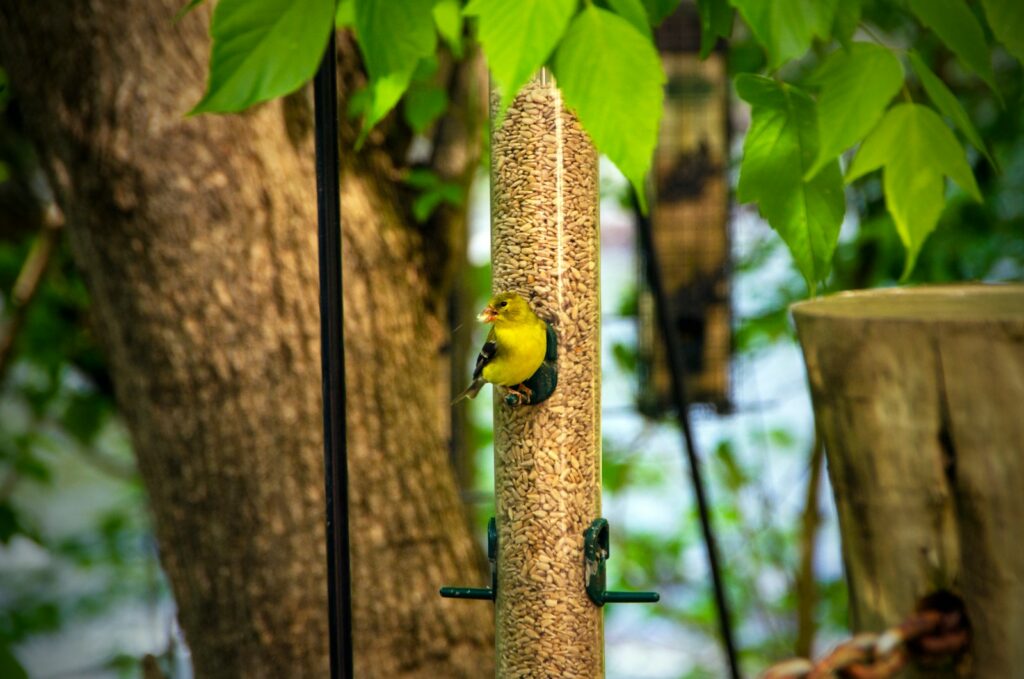
American goldfinches demonstrate remarkable agility when feeding, particularly on their favorite food sources like thistle and sunflower seeds. Their small, dexterous feet allow them to cling to even the flimsiest stems of seed-bearing plants, often hanging in seemingly impossible positions to reach prized seeds. At thistle feeders, goldfinches showcase their acrobatic talents by hanging upside-down and sideways, maintaining perfect balance while extracting tiny nyjer seeds from small ports. Their specialized bills are perfectly adapted for seed extraction, working like tweezers to remove seeds from tight spaces while their bodies remain in gravity-defying positions.
Woodpeckers: Vertical Surface Specialists
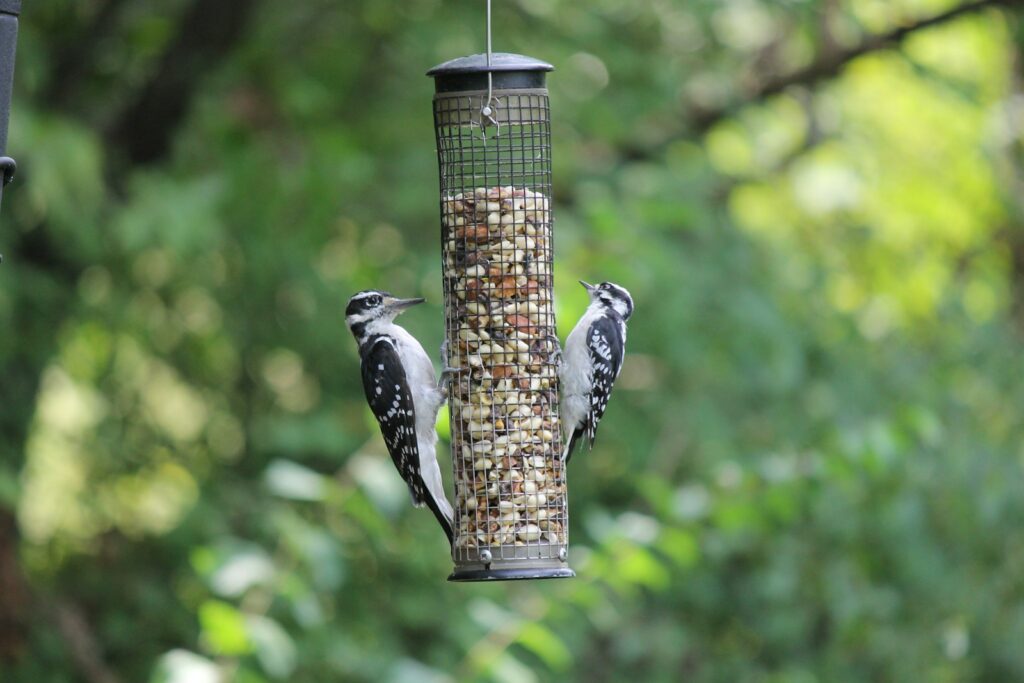
Downy, hairy, and red-bellied woodpeckers bring unique acrobatic abilities to backyard feeders through their specialized adaptations for vertical feeding. Their distinctive feet feature two toes pointing forward and two pointing backward (zygodactyl arrangement), creating a perfect grasping mechanism for clinging to vertical surfaces like tree trunks and suet feeders. Woodpeckers’ stiff tail feathers serve as a third point of contact, forming a supportive tripod that provides exceptional stability when feeding in vertical positions. These adaptations allow woodpeckers to comfortably maintain positions that would be impossible for most other birds, accessing food sources on vertical surfaces with apparent ease and stability. At suet feeders, they demonstrate remarkable agility, feeding upside-down or sideways while maintaining perfect control.
Titmice: The Hanging Seed Extractors
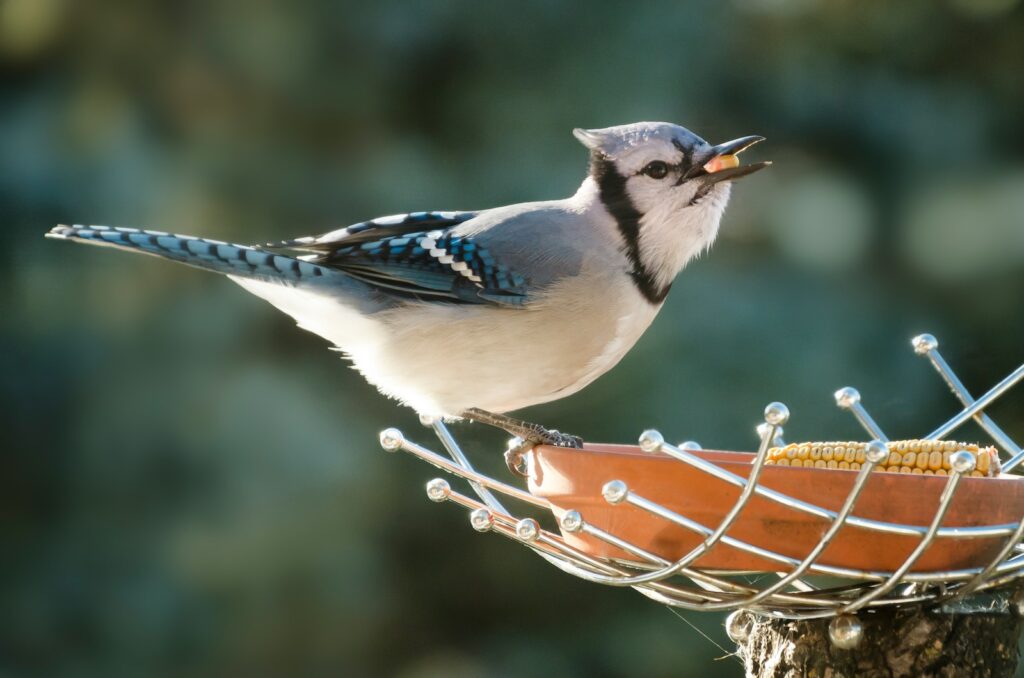
Tufted titmice demonstrate impressive acrobatic abilities at feeders through their grab-and-go feeding strategy. These agile birds will often hang briefly from a feeder perch using one foot while the other foot grabs a seed, showing remarkable balance and coordination. Unlike some birds that eat seeds in place, titmice frequently perform quick aerial maneuvers to snatch a seed and retreat to a nearby branch where they hold the seed with their feet while pecking it open. Their strong legs and sharp claws allow them to maintain stable positions even when hanging from thin branches or feeder edges at odd angles. This, combined with their quick, precise movements, makes them among the most entertaining acrobats to watch at backyard feeders.
Finches: Aerial Seed Processing Masters
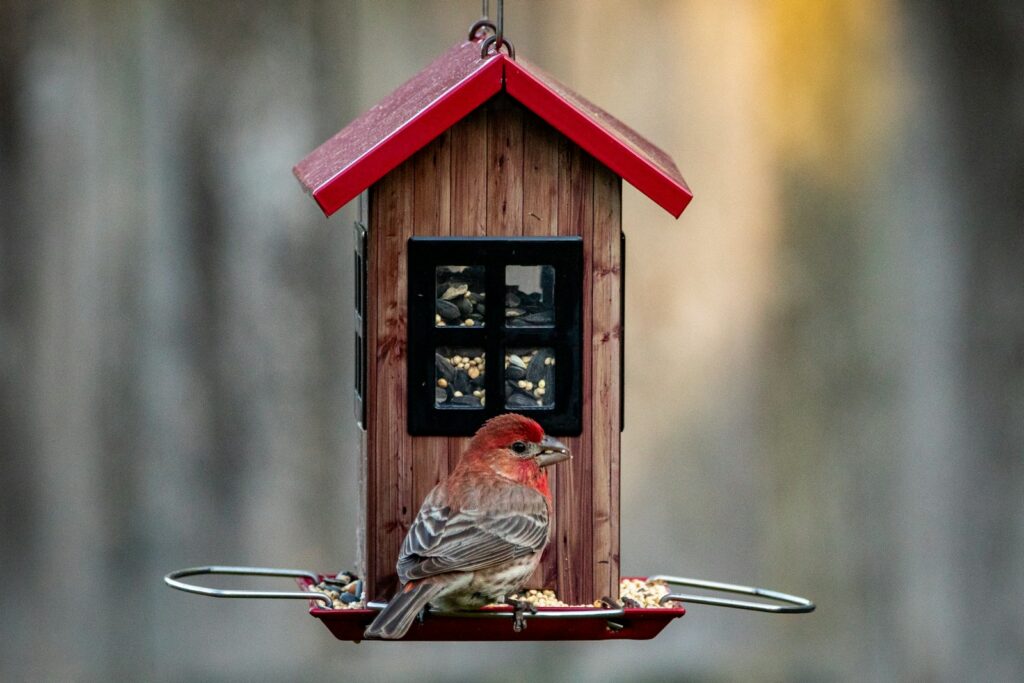
House finches and purple finches display remarkable dexterity in how they process seeds, often performing complex manipulations while maintaining precarious positions. These birds can rotate seeds in their specialized bills to find the perfect cracking position, all while perched on narrow edges or clinging to mesh feeder surfaces. Their strong feet allow them to hang from various positions on feeders, sometimes feeding upside-down or sideways to access preferred feeding ports. What makes their acrobatics particularly impressive is how they can maintain these challenging positions while simultaneously performing the complex task of husking seeds, which requires precise coordination between the bill muscles and tongue movements.
Pine Siskins: The Swinging Acrobats
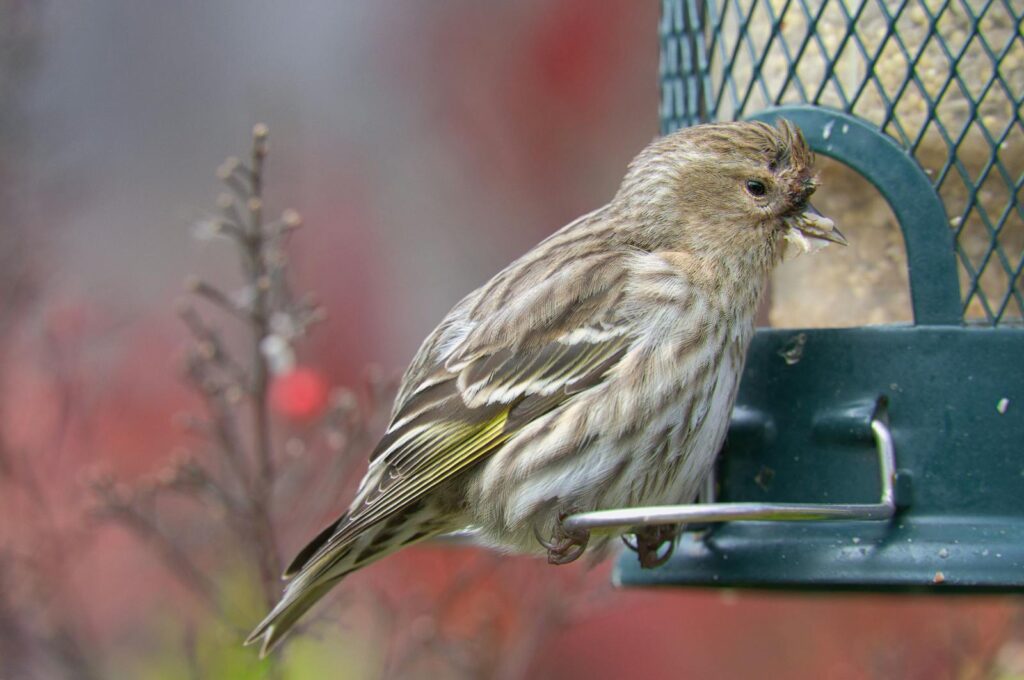
Pine siskins demonstrate extraordinary acrobatic abilities when feeding, especially at thistle feeders and on natural seed sources. These energetic little finches can hang upside-down from the flimsiest of perches, including thin thistle stems and feeder ports, using their specialized feet to maintain a secure grip while extracting seeds. What distinguishes pine siskins is their comfort with movement while feeding—they will continue extracting seeds even as their perch sways or bounces, maintaining perfect balance throughout. Their slender bills allow them to extract tiny seeds from tight spaces that other birds cannot access, often performing these extractions while hanging in seemingly impossible positions. In winter flocks, their coordinated movements create an aerial ballet as dozens of birds swing and sway on feeders and seed-bearing plants.
Wrens: The Vertical Surface Climbers

Carolina wrens and house wrens display remarkable climbing abilities that they apply to feeding situations, scaling vertical surfaces with mouse-like agility. Their relatively long, curved claws provide an exceptional grip on rough surfaces like tree bark, allowing them to navigate vertical and even overhanging surfaces with ease. At suet feeders, wrens can approach from any angle, climbing up, down, or sideways to access food, sometimes even hanging upside-down briefly. Their compact bodies with a low center of gravity enhance their stability during these acrobatic maneuvers, while their strong legs provide the power needed for vertical climbing. These adaptations evolved to help wrens search for insects in crevices and under bark, but translate perfectly to navigating complex feeder structures.
Warblers: The Flycatching Specialists
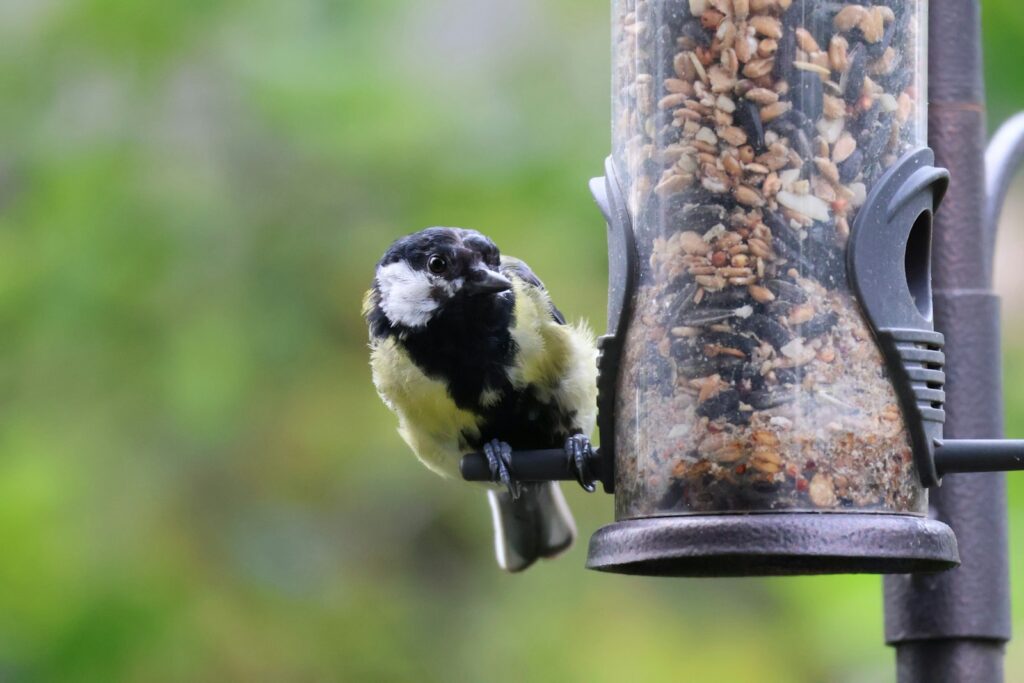
Certain warbler species that visit backyard feeders, such as pine warblers and yellow-rumped warblers, demonstrate impressive aerial maneuvers when catching insects. These birds can launch from a perch, perform mid-air directional changes to intercept flying insects, and return to their starting point with pinpoint precision. Their lightweight bodies and high muscle-to-weight ratio allow for exceptional maneuverability, enabling sharp turns and sudden stops that larger birds cannot match. At suet or peanut butter feeders, these same acrobatic skills let warblers approach from varied angles, often hovering briefly before landing or snatching a morsel mid-flight. Their ability to transition between perched feeding and aerial maneuvers showcases the versatility that makes warblers among the most graceful aerial performers in the backyard.
Bushtits: The Hanging Swarm Feeders
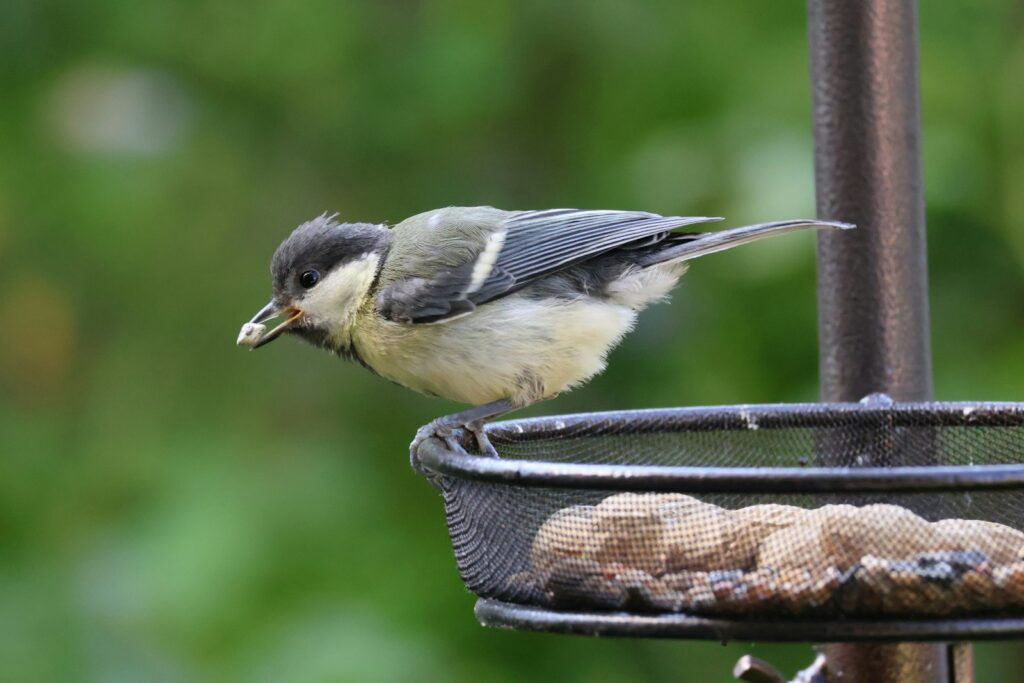
In western regions, bushtits demonstrate unique group acrobatics when feeding, often arriving at suet feeders in tight-knit flocks of 10-30 birds. These tiny birds create a mesmerizing display as they hang from every available surface of a feeder, including from each other, forming living chains of feeding birds. Their diminutive size (among the smallest perching birds in North America) and light weight allow them to hang from the flimsiest of perches without disturbing them. Bushtits’ long tails help them maintain balance during these acrobatic feeding sessions, acting as counterweights while they hang in various positions. Their coordinated movements create an impression of a single organism flowing around the feeder, making their group acrobatics among the most fascinating feeding behaviors to observe.
Orioles: The Hanging Nectar Specialists
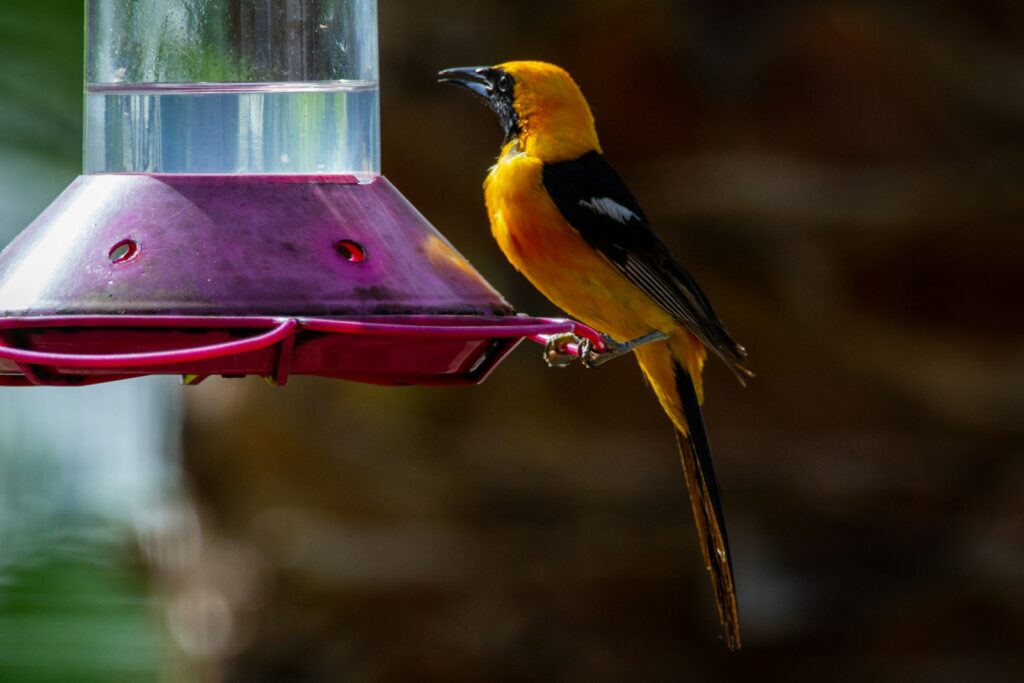
Baltimore and Bullock’s orioles bring extraordinary acrobatic abilities to specialized feeders, using their agility to access sugar water and fruit. These colorful birds can hang upside-down from perches, maintaining this inverted position with remarkable stability while feeding on orange halves or specialized nectar feeders. Their strong feet allow them to maintain secure grips even when hanging from smooth surfaces like orange peels or feeder ports. In natural settings, orioles use these same acrobatic skills to reach nectar from hanging flowers or extract insects from the undersides of leaves, adaptations they’ve perfectly transferred to backyard feeding situations. Their slender, specialized bills add to their feeding precision, allowing them to extract nectar or probe fruit while maintaining challenging positions.
Supporting Your Backyard Acrobats
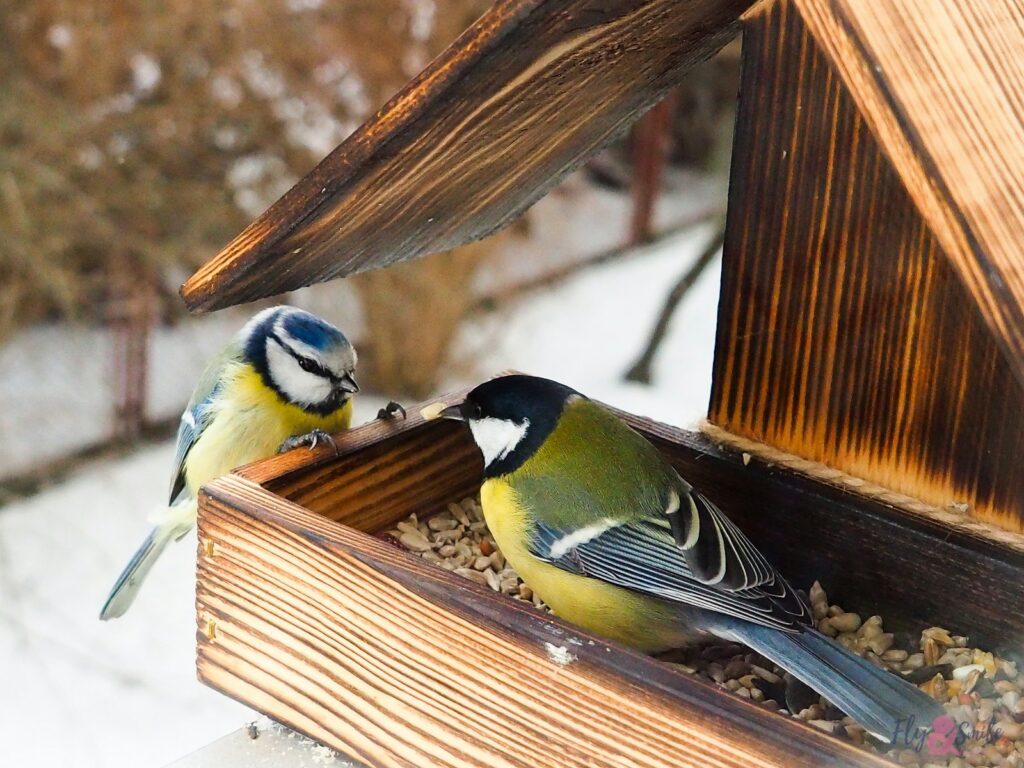
To attract and support these aerial performers, offer a variety of feeder types that allow birds to demonstrate their specialized feeding behaviors. Thistle feeders with small ports encourage goldfinches and pine siskins to display their clinging abilities, while suet cages allow woodpeckers and nuthatches to demonstrate their vertical feeding skills. Consider adding specialized feeders like nectar feeders for hummingbirds and orioles, and peanut feeders that require birds to extract food items through mesh openings. Position feeders near windows where you can observe the acrobatics clearly, but maintain safe distances to prevent window collisions. Remember that natural food sources like native plants with seed heads encourage even more varied acrobatic behaviors, as birds navigate the natural architecture of stems, seed heads, and branches.
Conclusion
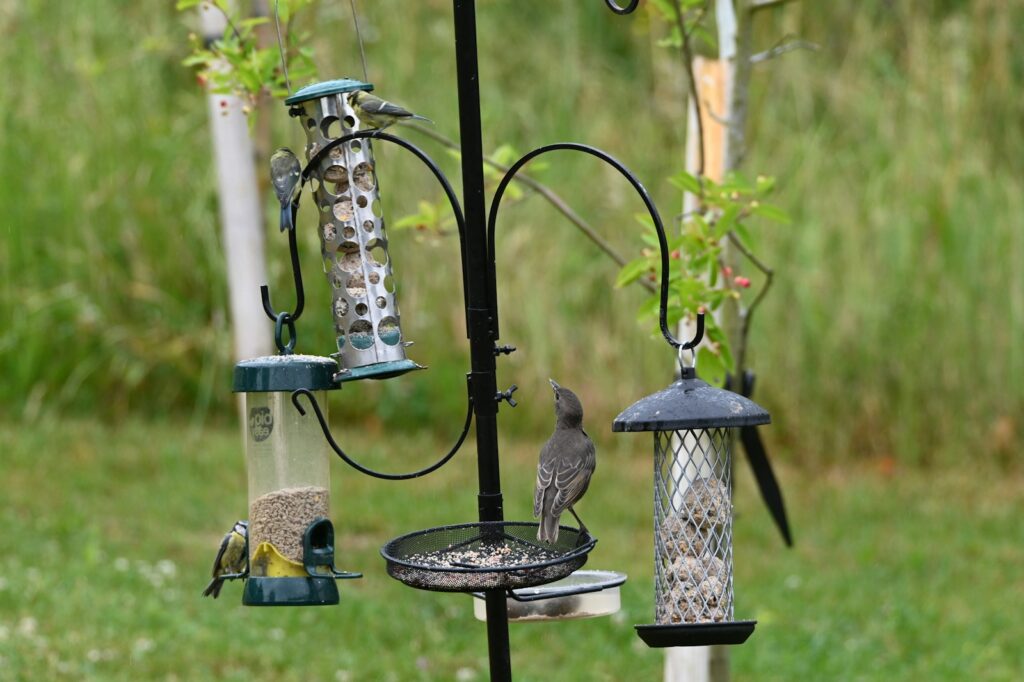
The acrobatic feeders that visit our backyards represent some of nature’s most specialized evolutionary adaptations in action. Each gravity-defying maneuver showcases millions of years of adaptation that have allowed these birds to access food sources in ways their competitors cannot. By providing diverse feeding opportunities through various feeder types and natural plantings, backyard bird enthusiasts can create stages for these aerial performances while supporting bird populations. Next time you observe a chickadee hanging upside-down or a hummingbird hovering with precision, remember you’re witnessing the result of evolutionary processes that have created perfect solutions to the challenges of finding food in a three-dimensional world. These backyard acrobats bring daily reminders of nature’s ingenuity and beauty right to our windows.
